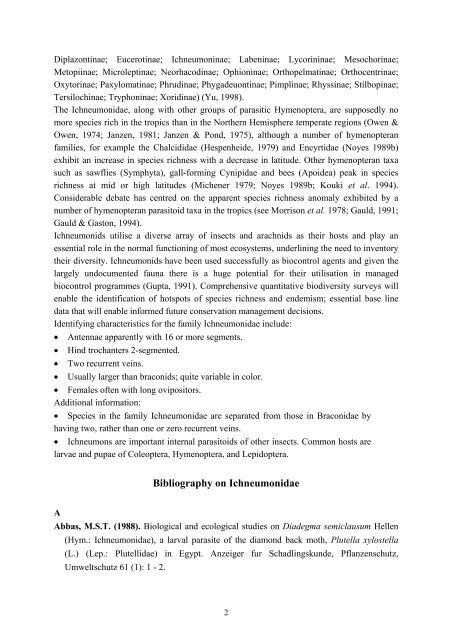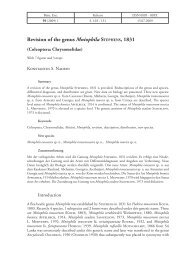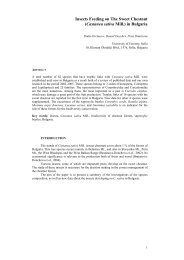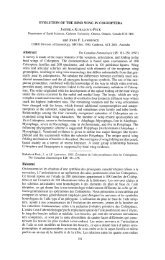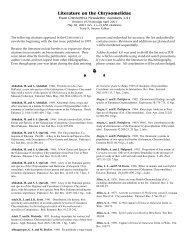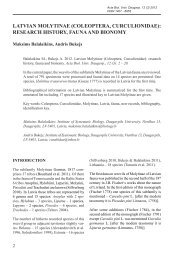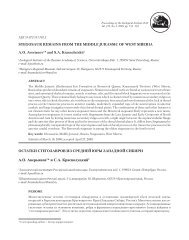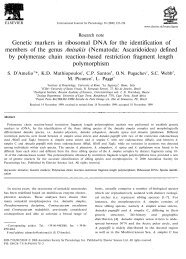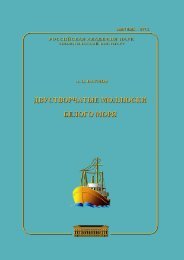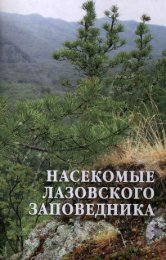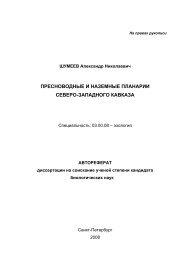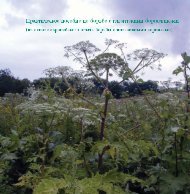Ichneumonidae (Hymenoptera)
Ichneumonidae (Hymenoptera)
Ichneumonidae (Hymenoptera)
Create successful ePaper yourself
Turn your PDF publications into a flip-book with our unique Google optimized e-Paper software.
Diplazontinae; Eucerotinae; Ichneumoninae; Labeninae; Lycorininae; Mesochorinae;<br />
Metopiinae; Microleptinae; Neorhacodinae; Ophioninae; Orthopelmatinae; Orthocentrinae;<br />
Oxytorinae; Paxylomatinae; Phrudinae; Phygadeuontinae; Pimplinae; Rhyssinae; Stilbopinae;<br />
Tersilochinae; Tryphoninae; Xoridinae) (Yu, 1998).<br />
The <strong>Ichneumonidae</strong>, along with other groups of parasitic <strong>Hymenoptera</strong>, are supposedly no<br />
more species rich in the tropics than in the Northern Hemisphere temperate regions (Owen &<br />
Owen, 1974; Janzen, 1981; Janzen & Pond, 1975), although a number of hymenopteran<br />
families, for example the Chalcididae (Hespenheide, 1979) and Encyrtidae (Noyes 1989b)<br />
exhibit an increase in species richness with a decrease in latitude. Other hymenopteran taxa<br />
such as sawflies (Symphyta), gall-forming Cynipidae and bees (Apoidea) peak in species<br />
richness at mid or high latitudes (Michener 1979; Noyes 1989b; Kouki et al. 1994).<br />
Considerable debate has centred on the apparent species richness anomaly exhibited by a<br />
number of hymenopteran parasitoid taxa in the tropics (see Morrison et al. 1978; Gauld, 1991;<br />
Gauld & Gaston, 1994).<br />
Ichneumonids utilise a diverse array of insects and arachnids as their hosts and play an<br />
essential role in the normal functioning of most ecosystems, underlining the need to inventory<br />
their diversity. Ichneumonids have been used successfully as biocontrol agents and given the<br />
largely undocumented fauna there is a huge potential for their utilisation in managed<br />
biocontrol programmes (Gupta, 1991). Comprehensive quantitative biodiversity surveys will<br />
enable the identification of hotspots of species richness and endemism; essential base line<br />
data that will enable informed future conservation management decisions.<br />
Identifying characteristics for the family <strong>Ichneumonidae</strong> include:<br />
• Antennae apparently with 16 or more segments.<br />
• Hind trochanters 2-segmented.<br />
• Two recurrent veins.<br />
• Usually larger than braconids; quite variable in color.<br />
• Females often with long ovipositors.<br />
Additional information:<br />
• Species in the family <strong>Ichneumonidae</strong> are separated from those in Braconidae by<br />
having two, rather than one or zero recurrent veins.<br />
• Ichneumons are important internal parasitoids of other insects. Common hosts are<br />
larvae and pupae of Coleoptera, <strong>Hymenoptera</strong>, and Lepidoptera.<br />
A<br />
Bibliography on <strong>Ichneumonidae</strong><br />
Abbas, M.S.T. (1988). Biological and ecological studies on Diadegma semiclausum Hellen<br />
(Hym.: <strong>Ichneumonidae</strong>), a larval parasite of the diamond back moth, Plutella xylostella<br />
(L.) (Lep.: Plutellidae) in Egypt. Anzeiger fur Schadlingskunde, Pflanzenschutz,<br />
Umweltschutz 61 (1): 1 - 2.<br />
2


